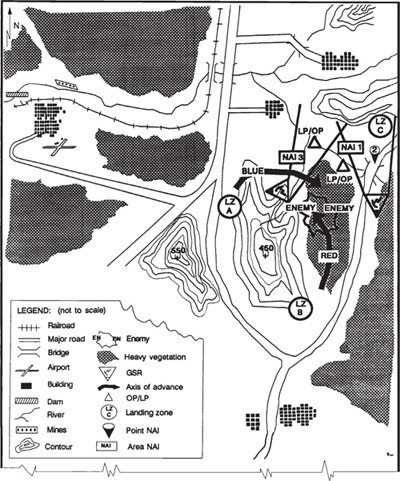
R&S assets available during LIC operations depend on mission and host-nation support. Peacetime contingency operations will require less R&S assets than counter-insurgency operations. Close coordination with the host nation will be vital. Information received from local agencies will supplement the R&S plan.
Typical collection assets available to brigade and battalion S2s during LIC operations include:
Additional assets depend on force package and may include:
Patrols
In LIC operations, patrolling is one of the primary ways to obtain and develop information. Patrols collect data on population, insurgent activity, and terrain by using a combination of route, zone, and area reconnaissance.
Effective patrolling provides the location, strength, and disposition of insurgent forces. Patrols can confirm insurgent weapons and the presence of foreign military advisors. Areas requiring special attention while planning patrols include rivers, streams, and agricultural areas. Patrols conducted around key installations give early warning and prove effective during CR or security missions.
Limitations to consider include communication and security. The primary means of communication for dismounted patrols is the FM battery-powered AN/PRC-77. Also, the patrol’s small size leaves it vulnerable to ambush or attack.
The scout platoon gathers information on insurgent forces while conducting patrols or by established OPs in assigned areas. They conduct much the same missions as patrols from the line companies, but scouts usually extend out farther than company patrols. Examples of missions that scouts conduct include:
Augmenting patrols with attached interrogation assets can add to the patrol’s ability to gather intelligence by interrogation or questioning of the local populace.
Augmentation of native scouts familiar with the area provide an advantage. Again, communications and security are primary limitations to scout operations.
GSR
GSR missions in an LIC environment may include continued search of open areas or surveillance of point targets. GSRs are very effective when integrated into R&S plans for installations, bases, and airfield security. They can verify activity detected by other sources (such as OPs, REMBASS, NODS) or vector friendly patrols.
The AN/PPS-5 and AN/PPS-15 are currently found in MI battalions supporting airborne and air assault divisions. The AN/PPS-15 is found in light infantry division MI battalions. System use depends on the AO and the mission.
GSR limitations include LOS to target. This is a key factor when insurgent activity occurs in forested or urban areas.
Extremes in weather such as rain, wind, or snow will degrade their operations.
AN/PPS-5 users must consider the system’s weight if the mission is in rough terrain or requires quick movement. It weighs in excess of 110 pounds without batteries, which are 12 pounds each.
Rembass
REMBASS is a valuable asset in the LIC environment. REMBASS gives indications on the amount of traffic along suspected insurgent trails, and it provides early warning when used along routes leading to possible insurgent targets or friendly base camps.
Sensors have a 24-hour, near all-weather capability. The information obtained cues the use of patrols, GSR, or OPs to confirm activity. Considerations when using remote sensors include radio LOS to the relay or monitoring station. The transmitting range is about 15 kilometers for sensors and repeaters, and up to 100 kilometers for airborne repeaters.
Voice Collection Teams
The MI battalion subordinate to heavy, light, air assault, and airborne divisions have voice collection teams capable of supporting the R&S effort. The AN/TRQ-32 TEAMMATE and the AN/PRD-10 provide IEW support. The QUICKFIX and GUARDRAIL (a corps MI brigade asset) can assist in the EW collection effort based on availability.
The AN/TRQ-32(V)(VI)(I) (TEAMMATE) will intercept HF, VHF, and UHF communications. It provides VHF LOB data. The power of the intercepted signal and LOS determine range capability. Limitations to be considered include mobility of the prime mover and security for systems when operating outside a security base.
The AN/PRD-10/11/12 is a mobile radio DF system. It can operate as a single station providing intercept and LOB data. When operating in the net mode with three other stations, the AN/PRD-10 provides intercept and manually computed radio DF fix locations of enemy transmissions. The AN/PRD-10 weighs approximately 80 pounds; its range depends on LOS and the power of the intercepted signal.
When available, the QUICKFIX or GUARDRAIL can conduct airborne DF. These systems have extensive range and can provide locations on enemy transmitters.
Evaluate all available assets within the brigade or battalion capable of supporting the R&S effort. Some assets and their capabilities follow:
Consider all human sources such as convoy truck drivers, FOs, and personnel from host-nation agencies or units (such as refugee camps, civil affairs checkpoints, local law enforcement, and intelligence.)
Fighting in an LIC environment requires a continuous R&S effort. This effort stresses reporting information to the S2 and disseminating that information no matter how insignificant. It also involves the total force. Figure 11-27 is an example of how these assets are employed in a battalion R&S plan.


Figure 11-27. Battalion R&S plan.